In "To Kill a Mockingbird," the mad dog represents the dangerous spread of racism and prejudice in Maycomb. When the dog appears, it shows how societal issues can distort people's minds, just like rabies affects a dog. Atticus Finch's struggle to deal with the mad dog mirrors his fight against the unfair treatment of Tom Robinson. The townspeople's panic highlights their fear of addressing these uncomfortable truths. This scene teaches valuable lessons about courage and standing up against injustice, showing that true bravery involves moral integrity. Curious to learn more about these connections and lessons?
Key Takeaways
- The mad dog symbolizes rampant racism and prejudice in Maycomb, reflecting societal issues that spread uncontrollably.
- Rabies in the dog distorts reality, paralleling how racism distorts community behavior and judgment.
- Both the mad dog and Tom Robinson represent innocence threatened by societal evils, highlighting the unfairness of quick judgments.
- Atticus's confrontation with the mad dog demonstrates moral courage in facing injustices, embodying the fight against societal prejudice.
- The incident prompts community reflection on their biases, emphasizing the need for awareness and action against injustice.
The Mad Dog as a Symbol
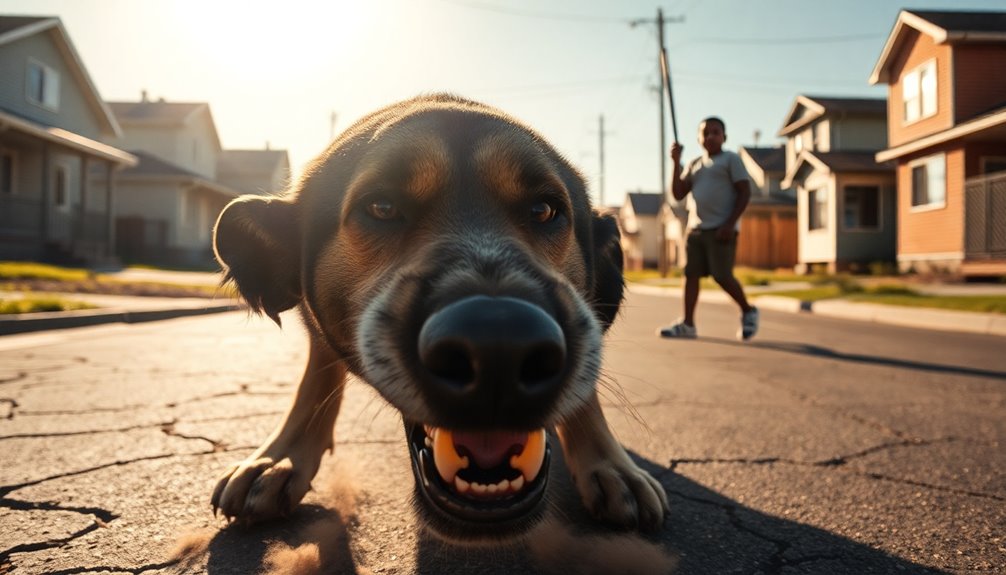
In *To Kill a Mockingbird*, the mad dog, Tim Johnson, serves as a powerful symbol of the rampant racism and prejudice lurking in Maycomb. When the mad dog appears, it represents how societal issues can spread like a disease, infecting the community with irrationality and fear. Just like the rabies affecting Tim, racism can distort people's minds and lead to violence, similar to how the mob reacts during Tom Robinson's trial.
Atticus Finch steps up to confront the mad dog, showing great moral courage. He doesn't shy away from danger; instead, he takes action to protect his community. This moment underscores the importance of facing harmful beliefs and behaviors head-on.
Moreover, the mad dog and Tom Robinson both symbolize innocence under threat. While the mad dog is a danger to the community, Tom represents the innocent victim of prejudice and hatred.
Atticus Finch's Moral Dilemma
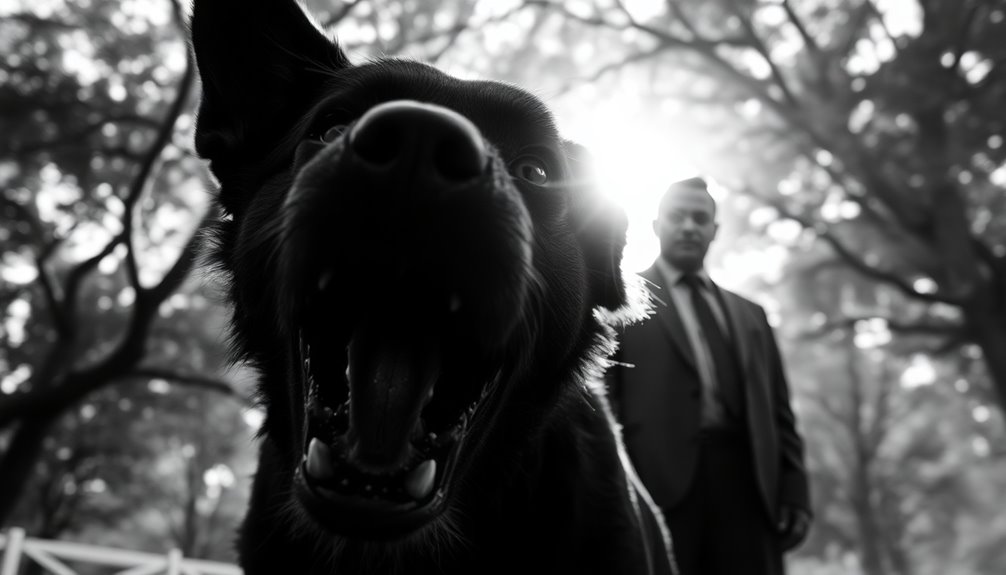
Facing the mad dog forces Atticus Finch into a profound moral dilemma that challenges his deeply held beliefs about violence and justice. You can see how much he values peace.
Atticus knows that to protect his community, he might've to kill the rabid dog. This situation reveals his internal struggle. On one hand, he understands the need to act against danger. On the other hand, he's reluctant to use violence, which goes against his moral compass.
When he finally makes the decision to shoot the mad dog, it's a pivotal moment for him. He confronts the harsh realities of his society, where societal evils like prejudice lurk.
Atticus aims to protect innocence, yet he realizes sometimes violence is necessary to keep the community safe. This moment shows just how complex his character is.
Community Reactions to the Incident
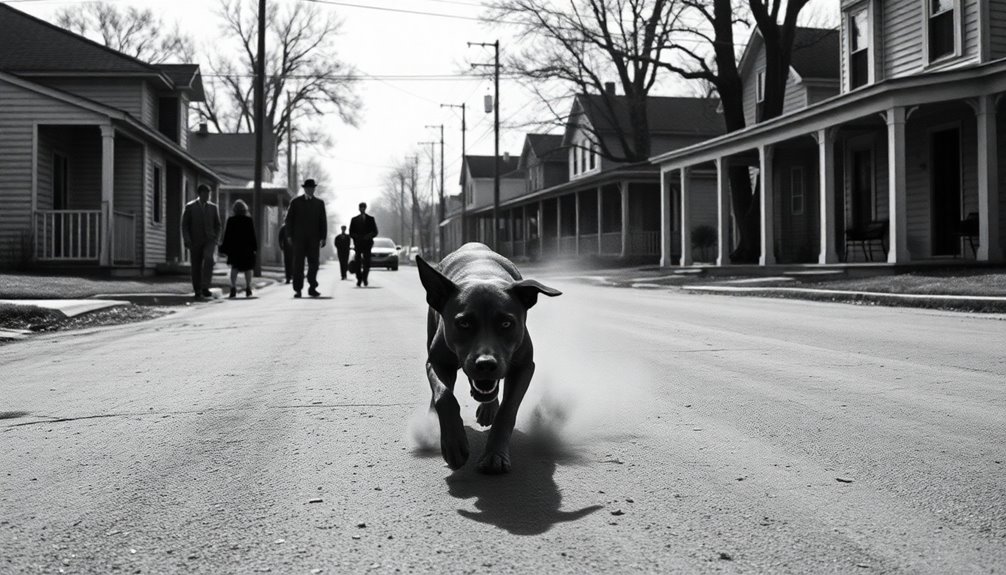
When the mad dog appears in Maycomb, the townspeople react with panic and fear.
It's interesting to see how their inaction shows a deeper problem—just like they hesitate to face racism, they struggle to deal with the immediate danger of the dog.
This moment highlights just how much they rely on Atticus to take charge, shining a light on their own fears and uncertainties.
Townspeople's Panic Response
The sudden appearance of the mad dog, Tim Johnson, sends shockwaves through Maycomb, igniting a palpable panic among the townspeople. Everyone rushes to see the commotion, their hearts racing with fear. They don't fully understand rabies and the danger it poses, which reflects their collective ignorance about deeper societal issues, like racism and prejudice.
As the chaos unfolds, Sheriff Heck Tate calls on Atticus to handle the situation, showing how much trust the community has in him. They see Atticus as a moral leader who can confront danger with calmness and courage.
While the townspeople gather, their panic reveals a larger reluctance to face uncomfortable truths. The urgency of the mad dog's presence spreads fear quickly, causing confusion and chaos. You can feel the tension in the air, with everyone unsure of what to do next.
But Atticus stands steady, showcasing a stabilizing force amidst the frenzy. His composed demeanor contrasts sharply with the townspeople's irrational responses, emphasizing the need for responsible leadership. This incident not only highlights their fear of the mad dog but also mirrors their hesitance to tackle pressing societal issues head-on.
Inaction and Fearfulness
Panic grips the townspeople as they watch Atticus prepare to confront the mad dog, but their fear leads to inaction. Instead of stepping up, they look to Atticus Finch, hoping he can handle the situation. This highlights a larger issue: the community's hesitation to face their own prejudices. Just like the mad dog poses a real danger, racism threatens their lives and society.
When the townspeople freeze in fear, they show how hard it's to confront uncomfortable truths. Their inaction reveals a struggle and a longing for social change, but fear holds them back. Atticus represents moral courage, stepping forward when others won't. By relying on him, the community avoids taking responsibility for their own actions.
The chaos surrounding the mad dog serves as a powerful reminder. It mirrors the way fear can paralyze people, preventing them from tackling their deep-seated issues. If they can't face a mad dog, how can they address their own prejudice?
This incident teaches that inaction, fueled by fearfulness, can keep a community from evolving and growing.
Connections to Tom Robinson's Trial
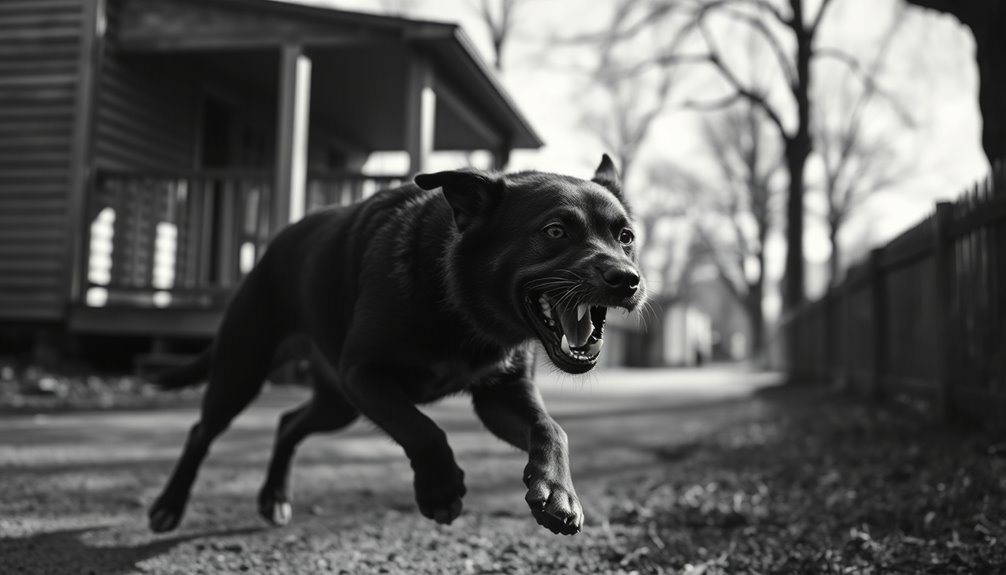
The mad dog in the story isn't just a scary creature; it stands for the unfairness and fear that swirl around Tom Robinson's trial.
Just like how people quickly judge the rabid dog, the town rushes to judge Tom, showing how prejudice can lead to terrible decisions.
Atticus's bravery in facing the mad dog reminds us that we need to stand up against wrongs in our world, just like he does for Tom.
Rabid Dog as Metaphor
In Maycomb, the rabid dog, Tim Johnson, serves as a powerful metaphor for the rampant racism that permeates the community, mirroring the irrationality surrounding Tom Robinson's trial. Just like the dog, racism is a fierce threat that must be confronted. Tom Robinson stands as an innocent man, wrongfully accused because of deep-seated prejudice.
Atticus Finch's decision to shoot the mad dog symbolizes his fight against the societal madness that fuels Tom's wrongful conviction. The rabid dog's illness reflects how prejudice can spread like a disease, infecting the minds of the townspeople and creating a mob mentality.
Take a look at the connections between the rabid dog and Tom Robinson below:
| Rabid Dog (Tim Johnson) | Tom Robinson |
|---|---|
| Represents societal madness | Represents innocence |
| Infects minds with rabies | Unjustly accused |
| Confronted by Atticus | Fights for justice |
| Symbolizes deep-rooted racism | Calls for moral courage |
This connection highlights the urgent need for moral courage in tackling these societal injustices. If we don't confront the rabid dog, we allow prejudice to thrive.
Prejudice and Quick Judgment
Quick judgments often lead to devastating consequences, as illustrated through the trial of Tom Robinson in *To Kill a Mockingbird*. The mad dog, Tim Johnson, symbolizes the prejudice and irrational fears that plague Maycomb. Just like the townsfolk panicked when they saw the rabid dog, they reacted with fear and hostility towards Tom Robinson simply because of his race. This irrationality brings out the worst in society, creating a kind of madness that clouds judgment.
Atticus Finch stands as a moral beacon in this chaos. When he shoots the mad dog, it's not just about protecting the town. It's a powerful statement against the quick judgments of his community. He defends Tom Robinson, who's unjustly accused, showing that everyone deserves a fair chance, regardless of skin color.
This connection between the mad dog and Tom's trial reveals the destructive impact of prejudice. The rabies that infects the dog serves as a metaphor for the 'disease' of racism, distorting perceptions and leading to severe consequences for innocent people like Tom.
In a world filled with fear, it's essential to remember that understanding, not quick judgment, is the key to healing our society.
Character Development Through the Event
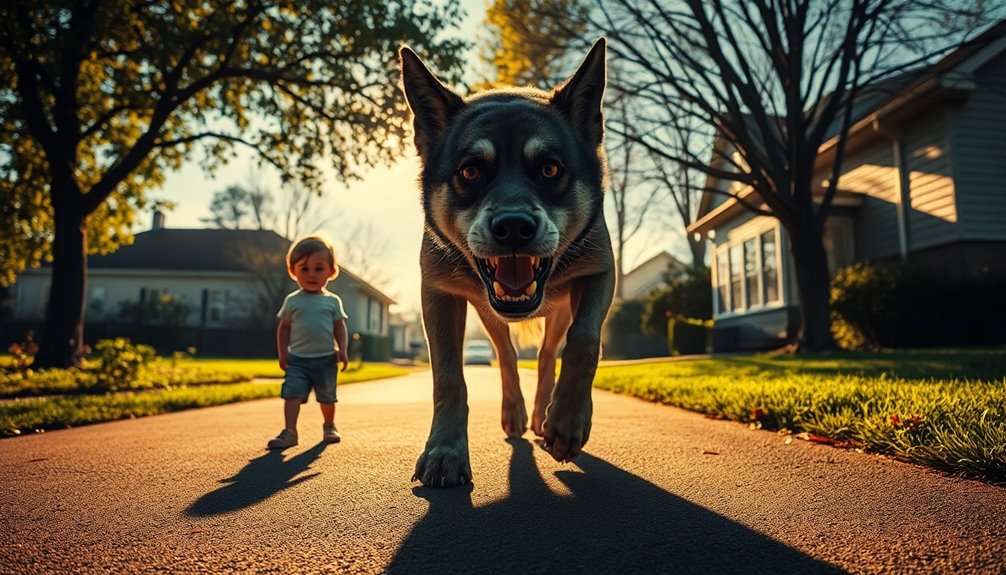
Throughout the mad dog incident, significant character development unfolds for Jem and Scout, marking a turning point in their perceptions of Atticus and the complexities of adulthood.
You see, as they witness Atticus's expert marksmanship, they realize that their father isn't just an ordinary man; he's hidden talents that reveal a deeper side of his character. This moment challenges their earlier views of masculinity and courage, showing them that true strength lies in moral integrity and responsibility.
As the children react to the chaos, Jem's desire to keep the incident a secret signals their growing maturity. They start to grasp the complexities of adult decisions, recognizing that life isn't always black and white.
Atticus's reluctance to kill the mad dog, despite his skill, reinforces his commitment to non-violence and shapes their values about justice.
This event acts as a catalyst for character growth in Scout and Jem. They begin to understand the importance of confronting societal dangers and the nuances of human behavior in their community.
Their journey through this experience leads them to appreciate the balance of bravery and ethics, setting the stage for their future adventures.
Themes of Courage and Justice

The mad dog incident powerfully illustrates themes of courage and justice within *To Kill a Mockingbird*. When Atticus Finch steps up to face the mad dog, he shows us what true courage looks like. This isn't just about bravery in the face of danger; it also mirrors his fight for justice during the Tom Robinson trial.
Just like the mad dog represents the dangerous threat of racism in Maycomb, Atticus's actions remind us that we must confront the prejudices in our community.
As he takes aim, the children realize that courage can come in many forms. Atticus isn't just a man with a gun; he's a symbol of standing up against injustice. The mad dog serves as a metaphor for the madness of societal racism, pushing everyone to recognize their biases and take a stand against wrongdoing.
In this way, the mad dog incident teaches us the importance of courage. It shows that real bravery is about doing what's right, even when it's hard. By confronting the mad dog, Atticus inspires us all to fight against prejudice and work for justice in our own lives.
Frequently Asked Questions
What Does Tim Johnson, the Mad Dog, Symbolize?
Tim Johnson, the mad dog, symbolizes the dangerous spread of prejudice and fear in a community.
Just like rabies can infect animals, ignorance can infect people, leading to harmful actions.
When Atticus shoots the dog, it shows his bravery in facing tough issues.
This moment makes you think about how courage is needed to fight against unfairness.
Tim Johnson's story teaches you about the importance of standing up for what's right, even when it's hard.
What Is the Mad Dog in to Kill a Mockingbird?
In "To Kill a Mockingbird," the mad dog is a stray animal that appears in Maycomb, creating a tense situation.
You see, this dog is rabid, which means it's dangerous and unpredictable.
Atticus Finch, the main character, has to shoot the dog to protect the town.
This moment shows how serious problems can arise unexpectedly, and sometimes, you've got to take action to keep everyone safe from harm.
It's a powerful scene!
What Does Atticus Killing the Mad Dog Symbolize?
When Atticus kills the mad dog, it symbolizes his bravery and moral strength.
Imagine a community where 60% of people struggle with prejudice—Atticus stands against this.
Shooting the rabid dog shows he's willing to protect his family and friends from harm. It's a tough choice, highlighting his belief in peace over violence.
This moment reveals to Jem and Scout that true courage often means facing difficult situations with integrity, not just strength.
What or Who Might the Mad Dog Symbolize?
The mad dog could symbolize many things! It might represent fear and danger in your community, showing how quickly things can go wrong.
You might also think of it as a sign of prejudice, reflecting how people can act irrationally when faced with something different.
Just like the dog, society can sometimes become wild and out of control.
It's a reminder that we need to confront these issues with courage and understanding!
Conclusion
To sum up, the mad dog in *To Kill a Mockingbird* is more than just a wild animal; it symbolizes the dangers of prejudice and fear in society. When Atticus faces the dog, he teaches us about bravery and standing up for what's right. Some might think it's just a minor event, but it's a turning point that connects to bigger themes, like justice and courage. So, let's celebrate these lessons and remember their importance in our lives!











